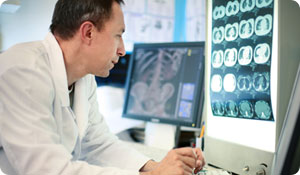
Every year, approximately 1.7 million people sustain a traumatic brain injury (TBI), according to the Centers for Disease Control and Prevention. Most of these cases are concussions or other mild forms of TBI in babies, preschool-aged children, older teenagers, and elderly adults. Injuries to different parts of the brain will affect different body functions, causing changes in the way the affected person thinks, acts, and moves as well as physical changes in functions such as temperature and blood pressure.
Causes
By clinical definition, TBI is the result of a traumatic external force, such as being hit by a blunt object or smashing your head against the windshield of a car. For diagnostic purposes, TBI differs from acquired brain injury, which is the result of a stroke or tumor, or non-traumatic external event such as almost drowning or experiencing an electric shock. Mild TBI refers to the degree of initial trauma, however, not to the resulting condition. Though most often treatable, a mild TBI can ultimately be just as devastating as a more severe injury.
Symptoms
According to the Brain Injury Association of America, the symptoms of mild TBI are most often temporary, though recovery time varies tremendously because no two brain injuries are exactly alike. Some of the symptoms of mild TBI are:
- Headache
- Fatigue
- Sleep, balance, and memory problems
- Sensitivity to noise or light
- Nausea
- Mood swings, depression and anxiety
Moderate brain injury is diagnosed when the patient loses consciousness for a few minutes or up to several hours, when confusion lasts for days or longer, and physical, mental, and behavioral problems related to the trauma last for months or do not go away. The good news is that people with moderate brain injuries can be treated and expect to recover and learn to compensate for any lasting disabilities.
When brain injury results in a coma or loss of consciousness for days or longer and the patient is in a vegetative or minimally responsive state, the diagnosis is severe brain injury.
Treatment
TBI treatment depends, naturally, on the nature and severity of the injury and generally begins in an emergency room. From there, a patient with mild injury will be given specific instructions that may include rest and avoidance of alcoholic beverages and any activities that could cause further injury to the head, such as riding a bicycle or driving a car. In the case of a moderate or severe injury, the patient may be admitted to the hospital's intensive care unit or transferred to a hospital with more targeted facilities.
Therapy and rehabilitation can take place in a variety of settings, from hospitals and rehabilitation centers to nursing homes and the patient's own home. Treatment may include speech, physical, occupational, or recreational therapies as well as psychological, counseling, and medical rehabilitation.
Rehabilitation is initiated as soon as possible to help the patient relearn skills necessary for daily living, such as eating, walking, speaking, and getting dressed. When necessary, therapy continues indefinitely to help the patient compensate for lost skills.
Support
For information on brain injury, you can call the national Brain Injury Information Center at 1-800-444-6443. To find local support, go to the Brain Injury Association of America's website at http://biausa.fyrian.com/state-affiliates.htm and use their locator map to find a state affiliate near you. A local hospital with rehabilitation facilities may also provide ongoing support.
Sources:
Brain Injury Association of America Web July 2012
http://www.biausa.org/about-brain-injury.htm
Centers for Disease Control and Prevention: Get the Stats on Traumatic Brain Injury in the United States Web July 2012
http://www.cdc.gov/traumaticbraininjury/pdf/BlueBook_factsheet-a.pdf
Los Angeles Caregiver Resource Center: Traumatic Brain Injury Fact Sheet Web July 2012
http://lacrc.usc.edu/damcms/sitegroups/SiteGroup1/files/fact-sheets/DMH%20Funded/Traumatic%20Brain%20Injury.pdf





